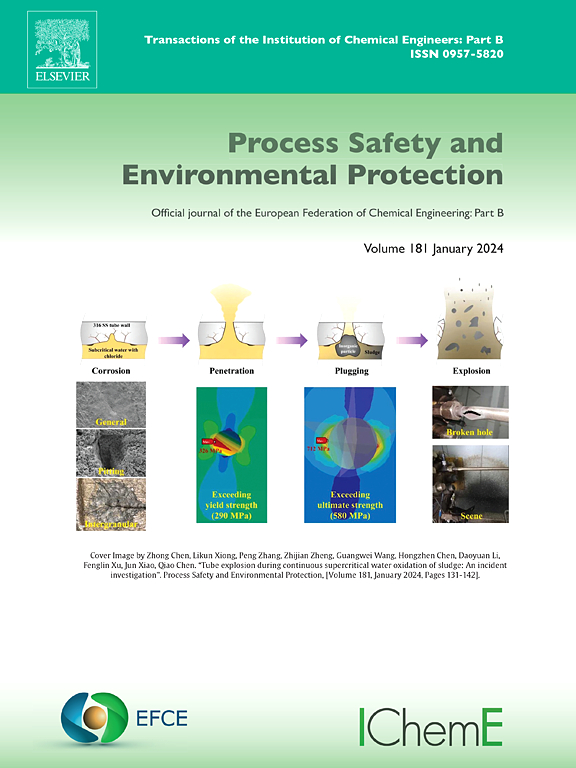Seasonal distribution and removal efficiency of microplastics in landfill leachate treatment plants in Istanbul, Turkiye
IF 6.9
2区 环境科学与生态学
Q1 ENGINEERING, CHEMICAL
引用次数: 0
Abstract
Due to inadequate management, plastic waste accumulates in landfills and transforms into microplastics (MPs), which concentrate in leachate and pose risks to ecosystems and human health. This study examines the seasonal variation, size, type, and removability of MPs in leachate from the Kömürcüoda (LTP-1) and Odayeri (LTP-2) landfill leachate treatment plants in Istanbul. Seasonal samples from raw leachate (RL), membrane bioreactor (MBR), ultrafiltration (UF), nanofiltration (NF), and nanofiltration concentrate (NFC) units were analyzed in spring and autumn. The highest MP concentrations were found in MBR units, with 29 particles/L in autumn and 11 particles/L in spring at LTP-1. In LTP-2, MP concentrations in anoxic and aerobic units were 20 and 24 particles/L in autumn and 17 and 26 particles/L in spring. Significant MP reduction was observed in UF and NF outlets, with an MP removal efficiency of approximately 97 % between RL and NF units at both sites. The predominant MPs were blue, black, and transparent fibers, ranging from 500 to 1999 µm in autumn and 1000 to >2000 µm in spring. Polymeric analysis identified polyamide (PA) as the most prevalent material at LTP-1 (42 %), followed by polypropylene (PP) and polyisoprene (PI), while at LTP-2, PP was dominant (46 %), followed by polyethylene (PE), PI, and PA. Despite high removal efficiencies, daily MP release after treatment was estimated at 5 × 10⁵ and 13 × 10⁵ particles for LTP-1 and LTP-2, respectively, indicating continued MP discharge. The high number of MPs detected in untreated landfill leachate, along with their persistence even after treatment processes, highlights the potential accumulation and toxicity risks posed by MPs released into aquatic ecosystems. Further research should focus on understanding the long-term environmental behaviour of these pollutants in receiving environments, as well as on improving advanced treatment technologies for MP removal.
土耳其伊斯坦布尔垃圾填埋场渗滤液处理厂微塑料的季节性分布和去除效率
由于管理不善,塑料废物在垃圾填埋场积累并转化为微塑料,这些微塑料集中在渗滤液中,对生态系统和人类健康构成威胁。本研究考察了伊斯坦布尔Kömürcüoda (LTP-1)和Odayeri (LTP-2)垃圾渗滤液处理厂渗滤液中MPs的季节变化、大小、类型和可去除性。在春季和秋季对原渗滤液(RL)、膜生物反应器(MBR)、超滤(UF)、纳滤(NF)和纳滤浓缩液(NFC)单元的季节性样品进行了分析。在LTP-1时,MBR单元的MP浓度最高,秋季为29颗粒/L,春季为11颗粒/L。在LTP-2中,缺氧和好氧单元的MP浓度秋季分别为20和24颗粒/L,春季分别为17和26颗粒/L。在UF和NF出口观察到显著的MP减少,两个地点的RL和NF单元之间的MP去除效率约为97%。主要的MPs为蓝色、黑色和透明纤维,秋季为500 ~ 1999µm,春季为1000 ~ 2000µm。聚合物分析发现,在LTP-1中,聚酰胺(PA)是最普遍的材料(42%),其次是聚丙烯(PP)和聚异戊二烯(PI),而在LTP-2中,PP占主导地位(46%),其次是聚乙烯(PE)、PI和PA。尽管去除效率很高,但估计治疗后LTP-1和LTP-2的每日MP释放量分别为5×10和13×10。未经处理的垃圾填埋场渗滤液中检测到大量的多聚体,即使在处理过程之后它们仍然存在,这突出了多聚体释放到水生生态系统中所带来的潜在积累和毒性风险。进一步的研究应侧重于了解这些污染物在接收环境中的长期环境行为,以及改进去除MP的高级处理技术。
本文章由计算机程序翻译,如有差异,请以英文原文为准。
求助全文
约1分钟内获得全文
求助全文
来源期刊

Process Safety and Environmental Protection
环境科学-工程:化工
CiteScore
11.40
自引率
15.40%
发文量
929
审稿时长
8.0 months
期刊介绍:
The Process Safety and Environmental Protection (PSEP) journal is a leading international publication that focuses on the publication of high-quality, original research papers in the field of engineering, specifically those related to the safety of industrial processes and environmental protection. The journal encourages submissions that present new developments in safety and environmental aspects, particularly those that show how research findings can be applied in process engineering design and practice.
PSEP is particularly interested in research that brings fresh perspectives to established engineering principles, identifies unsolved problems, or suggests directions for future research. The journal also values contributions that push the boundaries of traditional engineering and welcomes multidisciplinary papers.
PSEP's articles are abstracted and indexed by a range of databases and services, which helps to ensure that the journal's research is accessible and recognized in the academic and professional communities. These databases include ANTE, Chemical Abstracts, Chemical Hazards in Industry, Current Contents, Elsevier Engineering Information database, Pascal Francis, Web of Science, Scopus, Engineering Information Database EnCompass LIT (Elsevier), and INSPEC. This wide coverage facilitates the dissemination of the journal's content to a global audience interested in process safety and environmental engineering.
 求助内容:
求助内容: 应助结果提醒方式:
应助结果提醒方式:


